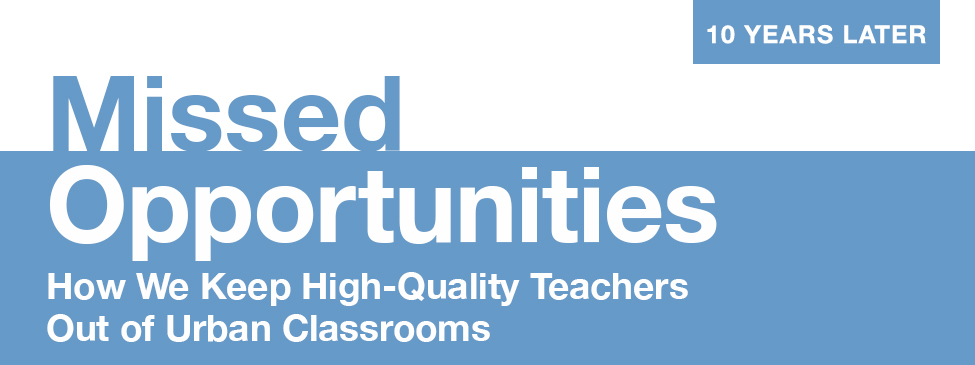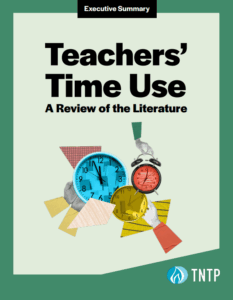This week, we’re taking a look back at our first-ever policy report, Missed Opportunities: How We Keep High-Quality Teachers Out of Urban Classrooms. When it was published in 2003, teacher shortages in urban districts were assumed to be caused by a dearth of qualified applicants. But we quickly discovered that that was not true—and there were things districts could do right away to hire their best-qualified candidates long before the school year began.
When we wrote Missed Opportunities 10 years ago, the truth was plain to us: The most important instructional decision a school can make is choosing the teacher that they hire. But in cities where we worked, we found dysfunctional, Rube Goldberg-like staffing systems that all but ensured that the best-qualified candidates would be turned off. Applicants were treated poorly, hiring took months, and offers sometimes arrived the same week school began. Not surprisingly, by that time, the best candidates had accepted jobs elsewhere, and those who were left were far less talented.
It was easy to chalk up shortages or widespread low performance to having too few qualified candidates, as most people did, or to incompetence in district human-resources offices, which others did too. But we combed through thousands of applicant records and district documents in four cities and interviewed aspiring teachers about why they ultimately chose to work elsewhere to get the true story.
We found that, on the contrary, there were plenty of qualified teachers who wanted to work in city schools, and that the factors preventing them from doing so came from all directions, everything from late budgeting timelines and seniority rights in union contract rules, to state regulations that allowed retirees to announce their plans leave days before the school year began.
Human resources departments were trapped under a tall pile of compliance-oriented policies and practices. Principals were disconnected from hiring decisions by forced-placement policies that assigned teachers to schools with no regard to talent or fit, and prevented them from making offers to external candidates until after excessed teachers were forced on them; a process that all too often hurt the highest-poverty schools most.
The impact on teacher quality was devastating: With every month that went by, the pool of available candidates dwindled. As we noted in the report, those who withdrew had significantly higher undergraduate GPAs, were more likely to have a degree in their teaching field and were more likely to have had prior coursework in education.
Fast forward ten years: Memphis, where I live and work, as part of its bold Teacher Effectiveness Initiative, adopted new hiring policies that are totally consistent with the recommendations we made in 2003. The city now has the most progressive set of human capital policies I know of, which put teacher talent at the center of virtually every major decision a principal or the district has to make. Here at home, we’ve seen great improvement in student learning and teacher performance—the best testament to the power of these ideas.
Filling a teacher vacancy in Memphis used to take months. Today, it’s just 10 days. And with two-thirds of vacancies identified by June, most teachers are hired very early in the hiring cycle, when the best-qualified candidates are looking for jobs. Last year, 100 percent of teachers were hired under a mutual consent policy in which school fit and freedom to hire the right candidate for the job were the guiding principles. A decade ago, HR slotting teachers into school vacancies without any say from the school was commonplace.
Teacher evaluations show us how powerful this sort of strategic, early hiring can be. In 2012, 60 percent of teachers hired in March, April and May earned top performance scores of 4 or 5 on a five-point scale, compared to only 40 percent of teachers hired in July. And the better the teacher performs, the more kids learn: At the recently re-staffed Ford Road Elementary school in the Memphis Innovation Zone, 87 percent of teachers earned top scores and student proficiency on math, reading and science tests increased by 19 percent, on average, in a single year.
This sort of progress isn’t limited to Memphis; in fact, the idea that early hiring is smart hiring is nearly as commonplace today as the assumption that there were weren’t enough qualified teachers interested in city districts was in 2003. Districts like Houston, New Orleans and Washington, D.C. have all taken similar steps, alongside other policies that focus on teacher talent.
This problem isn’t solved everywhere—Boston, where the majority of teachers are still hired in August, just announced it was taking on the issue last month. But the momentum is powerful. And 10 years in, we’re seeing fewer missed opportunities, and more chances for student success.








